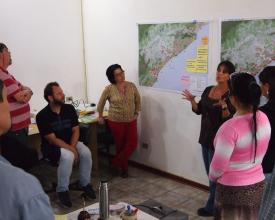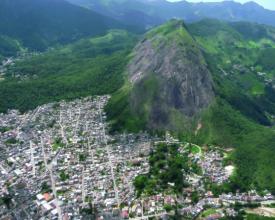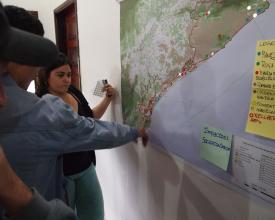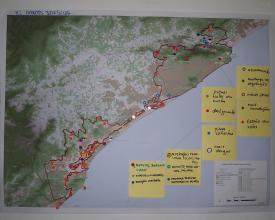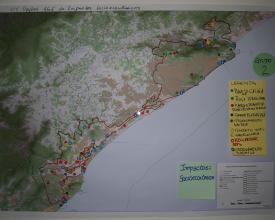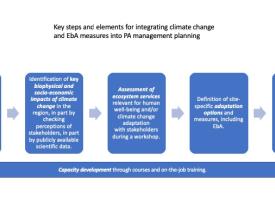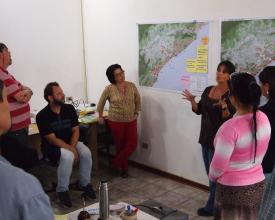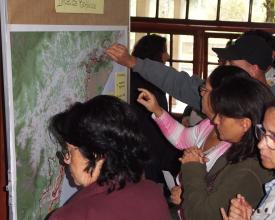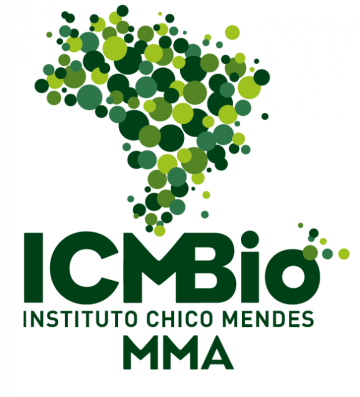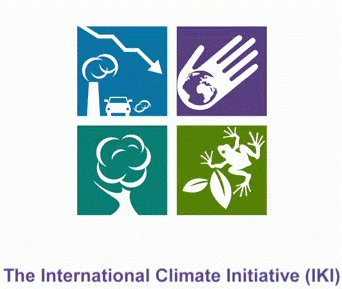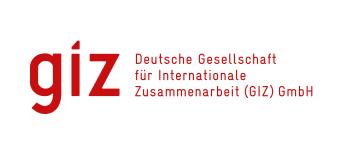
Integration of ecosystem-based adaption into protected area management planning
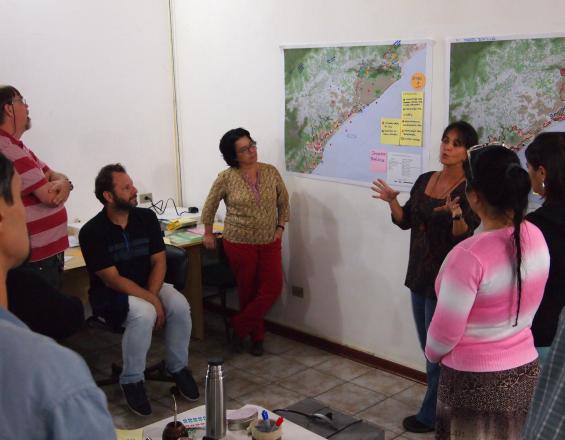
The solution describes a pilot process in Brazil with the aim of integrating climate change risks and opportunities as well as ecosystem-based adaptation measures into the management plan of the protected area “Cananéia-Iguape-Peruíbe”. This area is part of the “Mosaico Lagamar”, a network of conservation sites in the Atlantic rainforest. The solution provides insights into the approach and its methodological aspects as well as concrete indications for replication in other protected area planning processes.
Context
Challenges addressed
The Mata Atlântica is home to over 120 million people and is the engine room of the Brazilian economy, generating more than 70 % of the nation’s economic output. The region is an important biodiversity hotspot, despite the fact that it includes megacities such as São Paulo and Rio de Janeiro. Overall, about 22 % of the natural vegetation in the Atlantic coastal forests has been preserved, and the deforestation rate is stably low. Nevertheless, high degrees of fragmentation among the remaining forested areas continue to jeopardize the maintenance of biodiversity and ecosystem services. Extreme weather events such as floods and long periods of drought have had devastating socio-economic consequences for the population and the economy in recent years. The challenge in this biome lies in the conservation and restoration of natural forests in order to secure the ecosystem services that are important for life and business, such as the supply of drinking water to the large metropolitan areas.
Location
Process
Summary of the process
Building block (BB) 1: Methodological approach for integration of climate change and EbA into protected area management planning is the centre piece of the solution. It provides the guidelines for the implementation process (BB 3: Participatory process design and implementation), while BB 2: Institutional anchoring and broad-scaling is one of the expected outcomes of the initiative. The participatory process and continuous capacity development paved the way for the development and implementation of the methodological approach, while its transfer to other protected areas is key to further anchor it in protected area planning in Brazil.
Building Blocks
Methodological approach for integrating climate change and EbA measures into protected area management planning
The methodological approach consists of the following steps (see also graphic in the gallery):
- Collection of perceptions of involved professionals and other stakeholders with regard to key climate risks and spatial mapping of these risks.
- Identification of key biophysical and socio-economic impacts of climate change in the region, in part by checking perceptions of stakeholders, in part by publicly available scientific data.
- Assessment of ecosystem services relevant for human well-being and/or climate change adaptation with stakeholders during a workshop.
- Definition of site-specific adaptation options and measures, including EbA.
- Integration of results into the management plan.
- Capacity development through courses and on-the-job training as a crucial accompanying measure.
Enabling factors
- Availability of both scientific and other types and sources of knowledge and information.
- Participation and contributions from technical staff and citizens.
Lesson learned
- The first milestone was levelling knowledge about climate change concepts and issues among the participants. In this regard, the dynamic and participative format of the meetings and workshops was crucial for strengthening the understanding of main concepts and the appreciation and integration of stakeholder perspectives and knowledge into the management plan.
- The risk assessment should go beyond the conservation site and address its whole area of influence (e.g. water basins as an orientation for the scope).
- Participatory approaches and the integration of perceptions of climate change impacts can result in differing views. The responsible team needs to be prepared to deal with it.
- Likewise, the collection of local knowledge and perceptions can be resource-intensive and needs to be well-prepared.
- The integration of climate change risks and implementation of adaptation actions in conservation management is a rather new and complex task which is influenced by factors differing from site to site. Therefore, the adaptation process should be area-specific.
Institutional anchoring and broad-scaling
Through the elaboration of an EbA Action Program , the EbA approach was institutionally anchored in the protected area “Cananéia-Iguape-Peruíbe”. In addition, the methodological approach will be applied in eleven other protected areas in four federal states of the country through strategic partnerships with the Brazilian Environmental Ministry (MMA), the Brazilian Environmental Agenday (ICMBio) and others. The aspiration is that in the future, all protected area management plans consider EbA as a strategic response to climate change.
Enabling factors
- Agreements with and support from staff responsible for the elaboration and approval of management plans at central level of the protected area authority.
- Partnerships with other projects and financiers are an important catalyst and trigger point for replication, up- and broad-scaling.
Lesson learned
- It requires time as well as financial and personal resources to develop ready-to-use methodological approaches and to advocate for their dissemination and integration.
- There is a need to balance generalizable and context-specific issues.
Participatory process design and implementation
The starting-point was the agreement on the methodological steps (see BB 1) for the pilot project, including the involvement of key stakeholders and capacity development needs and measures. The upcoming revision of the management plan was an ideal entry-point for the integration of EbA and the work plan the key instrument. It defines that EbA should be treated in thematic meetings with different stakeholder groups and a workshop, in a specific chapter of the management plan and as part of an EbA Action Programme. Training of the core team was then followed by the collection of climate-related data and information which fed into the sessions with communities and a workshop.
Enabling factors
- Agreements with and support from staff responsible for approval of management plans.
- Clearly defined and broadly accepted work plan.
Lesson learned
-
The adaptation process should consider the ecosystem characteristics and the social and economic conditions within and beyond protected area boundaries. Therefore, a continuous and participatory process is needed, adressing the conservation priorities, climate and other risks as well as the needs and interest of stakeholders.
- The more participatory the process is being conducted, the more likely the EbA approach is to be integrated into the management plan of the protected area.
- There is a need do identify and involve all departments and levels of hierarchy of the organizations responsible for the protected area in order to ensure the integration of EbA. In our case, the final review by the superiors resulted in delays and observation, as some of them had not been involved previously.
- It is important to involve professionals with experience in EbA and protected area management planning. First of all, the project had to qualify professionals and other stakeholders involved in the process in order to succeed with the integration of the EbA-approach into the management plan.
Impacts
- Technical staff and inhabitants are aware of climate change risks and the potential of EbA measures in the protected area.
- Capacities for the identification and implementation of EbA measures have been strengthened.
- The administration team of the protected area now has a modern management plan which features prominently the maintenance of ecosystem services inter alia trough EbA measures. Its implementation will contribute to the reduction of climate change risks and enhance synergies between climate change adaptation and biodiversity conservation measures.
- A methodological guidance suitable for replication in other areas is available.
- The experiences and lessons learned as well as conceptual and methodological aspects from this pilot experience will be taken into account during the elaboration/updating of 11 additional management plans in the next two years.
Beneficiaries
Direct: Protected area staff, regional and local authorities
Indirect: Population (through the flow of ecosystem services)
Sustainable Development Goals
Story
The Mata Atlântica Project began its activities in the Lagamar region (São Paulo's southern coast and Paraná's coast) in 2014 with a capacity development program on EbA: Staff members of the protected area “Cananéia-Iguape-Peruíbe” (APACIP) and of other partner institutions were trained on the basics of EbA. The endeavor started with the discussion about potentials for EbA in the region and ways and means for implementation. As a result, the management plan of APACIP was the first to integrate EbA measures and the easy to use working methodology will hopefully serve others as a theoretical/practical reference.
“My involvement with the theme of ecosystem-based adaptation [in Spanish: AbE] began during the AbE course, held in July 2014 in Cananéia, São Paulo. Later I participated in the Training of Trainers course in AbE held in September 2014 in Brasília DF (Federal District). After participating in the course, and due to the proximity, I proposed the insertion of the AbE approach into the elaboration process of the Management Plan of APACIP. The participants of the process were the representatives of the community of users, managers of protected areas, researchers, entities of the public administration among other actors.The approach has resulted in rich contribution in people's perception of climate change and its effects on their daily activities, as well as in the processes of identifying potential environmental impacts and in proposing alternative solutions to the most probable impacts. In conjunction with the local community leaders, possible adaptations based on ecosystems were diagnosed according to their perceptions about the climate change, and were inserted in the content of the Management Plan. Particularly, I believe that the elaboration and publication of the APACIP Management Plan including EbA was a happy effort by professionals and people interested in the management of APACIP's natural resources, in a rare window of opportunity in public administration, culminating in a basic planning document , with the potential to boost advances in the territorial management of the estuarine mosaic of Cananéia, Iguape, Ilha Comprida and Peruíbe”.
Miguel Fluminhan Filho, Environmental analyst, APA Cananéia Iguape Peruíbe

